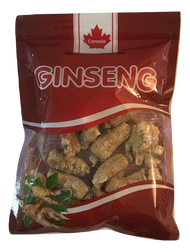- Home
- Healthy Nourishment &Specialties (保健品&加拿大特產品)
- Canadian Specialties (加拿大特產)
- Wild Ginseng(人蔘系列)
- PEACE PAVILION Semi-Wild Several Years Ginseng-Standard Bag package 454g(加拿大 PEACE PAVILION 西洋參 -多年半野參-標準袋裝 454g)
PEACE PAVILION Semi-Wild Several Years Ginseng-Standard Bag package 454g(加拿大 PEACE PAVILION 西洋參 -多年半野參-標準袋裝 454g)
Product Description
Fix Shipping Fee CA$10 ,Free shipping if order over CA$78, cover All Canada/USA/ Main Land of China. Please remember to entry coupon code Y72ZT4XKZG to get free shipping when you check out and order over CA$78.
固定邮费加幣$10,订单满加幣$78免邮,配送地區覆蓋全加拿大/美国地區/中國大陸地區,結帳時如購買金額超過CA$78,記得輸入coupon code Y72ZT4XKZG 以取得免運費優惠.
Description
Ginseng is any of eleven different varieties of short, slow growing perennial plants with fleshy roots. Ginseng is believed to restore and enhance normal well-being and has become one of the most popular herbal remedies in the world today.
The herbs consist of a light-colored, forked-shaped root, a relatively long stalk and green leaves with an oval shape.
Ginseng has traditionally been taken to aid a number of medical conditions, which we discuss below. However, as a note of caution, there remains little scientific research to back up how effective ginseng actually is for these.
Both American Ginseng (Panax quinquefolius, L.) and Asian Ginseng (P. Ginseng) are believed to provide an energy boost, lower blood sugar and cholesterol levels, reduce stress, promote relaxation, treat diabetes, and treat sexual dysfunction in men.
It should be noted that Siberian ginseng (Eleutherococcus senticosis) is not a true ginseng and doesn't belong to the genus "Panax". It does belong to the Araliaceae family of plants, but consumers should be aware that it is not the same as American or Asian ginseng.
History of ginseng
The word ginseng comes from the chinese term "rénshen", which literally translates into "man root". It is thought to have been given this name because the root of the plant looks like the legs of a man.
China
Over five thousand years ago, in the mountains of Manchuria, China, Panax ginseng was commonly used for its rejuvenating powers.
The herb was considered to be a symbol of divine harmony and its human shape was highly desirable.
The benefits of ginseng were first documented during China's Liang Dynasty (220 to 589 AD).
Chinese legend has it that early emperors used to use it as a remedy for all illnesses and not only consumed it, but also used it in soaps, lotions and creams.
In the third century A.C., China's demand for ginseng sparked huge international trade of the herb from other parts of the world - in exchange for silk etc.
North America
In 1716, a Jesuit priest in Canada heard that ginseng was extremely sought-after in China, so he searched for the herb in areas of French Canada - environmentally similar to Manchuria.
After three months of searching he finally found a herb nearly identical to Asian ginseng near the city of Montreal - the herb he found became known as American ginseng.
Soon after the discovery of American ginseng, botanists and herbalists found that it was common all over the deciduous forests of the eastern United States. The export of ginseng from North America to China began to explode.
However, the herb was over-harvested in the mid-1970s and soon became considered an endangered species.
Since farmers began cultivating the sensitive herb in the 1970s, American ginseng trade has been growing steadily.
Currently, the state of Wisconsin, in particular Marathon County, produces nearly 95% of American ginseng. The herb is also widely grown in the province of Ontario, Canada.
Possible health benefits of ginseng
Traditionally ginseng has been used to treat a number of different ailments.
However, it should be noted that ginseng's therapeutic properties are often questioned by Western scientists and health professionals because of little "high-quality" research determining its true effectiveness in medicine.
The following ginseng health benefit links have been suggested:
Energy provider,Cognitive function,Anti-inflammatory effects,Cancer prevention,Erectile dysfunction,Flu and RSV
Possible side effects of taking ginseng
Although ginseng is generally considered to be safe to consume, the following side effects have been reported:
- Headaches
- Elevated heart rate
- Nausea
- Restlessness
- Difficulty sleeping.
Women may also experience swollen breasts and vaginal bleeding.
Ginseng's associated complications
Doctors do not recommend taking ginseng along with a class of antidepressants called monoamine oxidase inhibitors (MAOIs), because it can cause manic episodes and tremors.
Ginseng can alter the effects of blood pressure and heart medications, including calcium channel blockers such as nifedipine (Procardia®). Never mix ginseng with heart medications without consulting your doctor first.
In addition, ginseng can increase the risk of bleeding when taken with drugs that affect blood clotting (such as warfarin or aspirin), according to the American Cancer Society.
Ginseng overdose
Symptoms of mild ginseng overdose include:
- Irritability
- Blurred Vision
- Edema
- Diarrhea
- Bleeding
- Fidgeting
- Excitation
- Dizziness
- Dry mouth.
Symptoms of severe ginseng overdose include:
- Decreased heart rate
- Vomiting
- Nausea
- Convulsions
- Delirium
- Seizures.
People who experience any of the symptoms listed above should stop taking ginseng and immediately seek medical attention.
切片含化
將人參切片含化是最便利、也是最常用的服用方法。方法是取人參片放口中,不要咀嚼,待其完全軟化後再嚼爛嚥下。通常買到的人參是整支而乾燥的,難以切斷。可將人參先放入碗或盆內,隔水蒸軟;也可在燜飯時放入,待飯熟人參也軟了;或將人參放入微波爐內加熱軟化。切參時要趁熱用鋒利的薄刀便可切出飲片,下刀時採取與參條呈45度的斜向下刀,這樣才能使參片切得薄而大,參片內殘留的纖維短,有效成份容易溶出。然後切薄片曬乾後裝入瓶內,放置陰涼處。瓶以不透光的深色為好,避免光照。瓶內放一小袋乾燥劑更好。每日含化的人參量不宜多,以3-5片為宜。含化人參的時間以早晨起空腹時為好。
研粉服用
將人參研製成細粉備用,方法是調和人參粉或送服人參粉。較普遍的方法是用白開水,牛奶、米飲湯沖服,也可以用生薑大棗湯、木瓜湯沖服。
用牛奶沖服人參粉口感好、營養價值全,可代早餐;米飲湯有助胃氣的作用,脾胃虛弱者可用之;生薑大棗湯能理氣和中,胃部不適者可之用之;木瓜湯可和中祛濕,治療吐瀉病可用之,一般取木瓜10克,加水煎取汁即可。現在很多工廠將加工好的人參粉末裝在膠囊中,既便利保存,亦方便服用。
製作食品
用人參製作食品或製作糕點,需將人參加工成極細粉末,可配伍其它藥物,再配合麵粉或米粉制做食用。通常家庭製作饅頭、麵包、麵條、米飯、烙餅等食品都可以使用人參粉。
做餡燒煮
用人參鮮品和干品均可作餡。用鮮人參宜先洗淨,切成小塊,再剁成泥拌入肉餡中,做為餃子、餛飩或湯圓餡食用。用人參干品宜先將人參加工成細粉,也可加水將人參燉熟搗成泥,然後再用。人參做餡食用要注意即作即食,這樣最好。
做羹煮粥
用人參做羹是一種非常好的食用方法。羹是湯汁稠厚的一種菜式,多以肉、蛋、豆腐等作主要原料。人參作羹食用多取新鮮人參為原料,將人參洗淨,切薄片或剁成細末再用。人參羹味美、易消化,更食用於老年人、體弱者、兒童食用。
將人參煮粥食用,有益脾胃、易於消化,而且能發揮人參補氣健脾的作用,尤其適宜於病後脾胃功能虛弱,或從事腦力勞動且消化功能較差者飲用。人參煮粥的方法可用整枝人參與粥同煮,也可以將粥煮好後撒入適量人參粉食用。
泡茶飲用
對於喜歡飲茶者,人參泡茶不失為既便利又實在的吃參方法。泡茶多取人參須,或人參薄片最好。不要用整支或成段的人參,原因是往往難以浸泡漲透,不利於其營養成份的充分利用。人參泡茶每次用量不宜多,1-3克即可,人參葉可加大到10克。特別提醒提高人參茶的口味,可適量加糖。體質與病症屬熱,欲養陰清火的,一般用西洋參、白糖參,可用冰糖調味;體質或病症屬寒,欲溫補者,一般用紅參,可用紅糖調味。一般情況下,可採用生曬參。
浸泡藥酒
用人參浸泡藥酒,這是最古老的食用人參方法之一,泡酒的人參最好是鮮人參,人參干品也可以。浸泡人參藥酒,要配伍多種藥材,因藥酒的功效各異,所以最好請中醫師在藥材配伍、浸泡時間等方面作指導以保證藥酒療效。浸泡藥酒需要上好白酒,一般要求白酒度數高於50度,否則容易變質。
烹製菜餚
用人參制做菜餚方法很多,如:煲湯、燉食、拌菜、溜炒等均可,在中國,最古老的方法是煲湯和燉食,而在韓國用人參製作菜餚的各種方法都有,而且隨時可以吃到人參菜餚,用於烹製拌菜、溜炒的人參菜餚多為鮮人參,或人參葉、人參須、人參果等;而煲湯和燉食用人參干品或鮮人參均可。
製作糖漿
製作人參糖漿的原料多採用加工白糖參過程中所存留的糖汁。一般生產1000克白糖參可得5000克人參糖汁。製作糖漿時,將此糖汁調節好濃度和人參皂甘含量,過濾、加防腐劑、分裝、滅菌,即得。
搗泥外敷
人參外敷是人參開發利用的一種新方法,是依靠人體皮膚吸收人參有效成份。方法是將新鮮人參洗淨、切片、搗成泥或再配伍其它藥材一起使用,外敷人參有潤膚美顏的作用,效果非常好。對瘡瘍久潰不愈者,還有助瘡瘍的癒合。在韓國美容行業普遍利用人參外敷美容。
局部搽擦
人參搽擦有三種方法:
(1) 將新鮮人參齊腰切斷,以人參斷面在局部搽擦;
(2) 將人參干品加工成超微粉達300目以上,將細粉放在局部,然後在上面搽擦;
(3) 提取人參有效成份,精製成護膚品在局部搽擦。 人參局部搽擦是透過肌膚的滲透作用於內臟,可收到增強腑臟功能,祛病健身的效果。
人參的綜合應用
目前,在人參綜合利用上有以下方面:
(1)醫藥行業:除傳統的人參入藥外,現代科技提取人參有效成份,製成各種中藥或西藥。
(2)保健行業:除傳統的食用人參外,各種人參製品已經廣泛的應用到人類保健。
(3)食品行業:利用人參製作各種食品、如:麵包、餅乾、糖果、人參米等。
(4)飲料行業:利用人參提取物製作各種飲料、茶、啤酒、露酒、沖劑、蜜漿等。
(5)美容美發:利用人參製作各種、面膜、洗面奶、護膚霜、護髮鋦油、等用於美容美發。
(6)洗浴日用:用人參製作各種潤膚液、香皂、香水、牙膏、人參洗浴液等
(7)飼料行業:利用人參作飼料添加劑,用於信鴿、珍禽、猛獸、軍犬、家禽的餵養。
注意事項:人參反藜蘆;畏萊菔子、五靈脂;服用期間忌食蘿蔔與濃茶。
人参可以和萝卜一同食用吗?
中医认为人参和莱菔子不能一起食用,不然人参效果大打折扣,莱菔子是萝卜的成熟种子,能消食导滞、降气化痰,主治食积或咳喘实证。其实人参与莱菔子、萝卜之间有着重要的联系。
传统医学认为,人参不能与萝卜同食,因为人参补气,而萝卜顺气,功效相抵。但在各类古籍中又不乏人参与萝卜同用以治病的例子:如《本草纲目》中记载:“人参、黄芪研末,红皮大萝卜蘸食,治阴虚血尿,亦可治沙淋、石淋。”所以服人参忌吃萝卜是没有科学根据的,两者同用,对某些疾病还是有特殊效果的。
现代医学也认为,吃人参可以与萝卜同食,是因为吃人参过多可导致上下不通,而萝卜能顺气。
人参粉的功效
人参粉就是人参打成的粉。主要有大补元气、补五脏、益元气、通血脉、生津止渴、安神益智等功效。人参粉主治劳伤虚损、厌食、劳累、反胃吐食、大便滑泄、虚咳喘促、自汗暴脱、惊悸、健忘、眩晕头痛、阳痿、尿频、消渴、妇女崩漏、小儿慢惊及身体虚弱,一切气血津液不足的症状。尤其在抢救休克病人的时候,可以发挥重要的作用,并且对糖尿病、心律失常、脑血管病、高血脂和消化不良也有一定的治疗作用,由于人参可以提高免疫力,因此对癌症患者也有作用。
人参粉怎么吃最好
1、人参不宜每天吃,每周进补2-3次就可以,否则容易过量。
2、寒性体质虚的人可以用人参粉泡酒喝,做法:200克人参粉加入4-5斤酒中,每次喝约30克。
3、将人参粉1-2克,用温开泡茶喝。
4、取人参粉5-10克冲入稀粥中食用, 每日吃一餐,适合消化功能较差的慢性胃肠病患者和年老体虚的人。
5、鸡蛋去壳打在碗中,加入人参粉1~2克和清水适量,调味,在搅拌均匀,然后蒸熟就可以了。
6、将人参粉和乌骨鸡一起加水炖熟,在调味就可以了,当然除了炖鸡外,也可以和别的一起炖。
食用人参粉的注意事项
1、人参虽好,却不是谁都适合吃人参的,小儿、青年人或身体健康的人都不必食用人参。人参中含有促进性早熟的成分,所以儿童要慎服,人参是大补的,体质虚弱的人可以使用。
2、久病体虚的人需要进补时,可以选生晒参。如果服用后出现口干舌燥、鼻子出血等,可能是不受补,可以选择药性偏凉的西洋参。肿瘤病人可以选择红参,如果出现不受补,可以改用西洋参。
3、人参的主要成分是人参皂甙、多种氨基酸、糖类、人参酸、维生素等,所以感冒发热时不宜服用。
4、身体实热的人不要食人参。有高血压的人也不能食用人参粉。
5、冬令进补,所以对于人参这一类补品适合在冬天这段时间来吃。
6、人参粉的不能一次用量过大,不然会出现中毒现象,有瘙痒、头痛、眩晕、出血、发烧表现,严重的会引起死亡。所以服用人参应该服用5天后休息两天,这个时间段不要超过两个月,两个月后休息一周。并且食用人参的时候不要饮茶,会影响人参的药效。

 Loading... Please wait...
Loading... Please wait...










